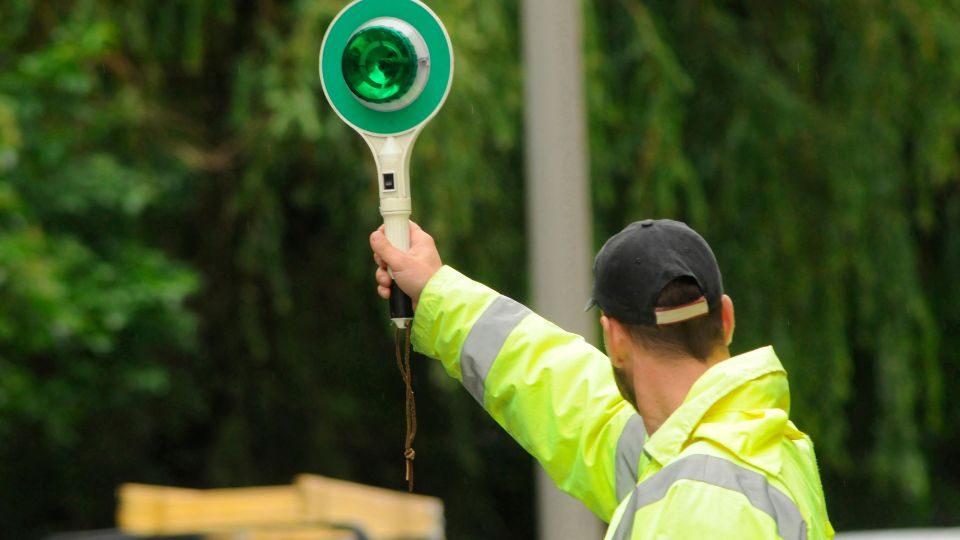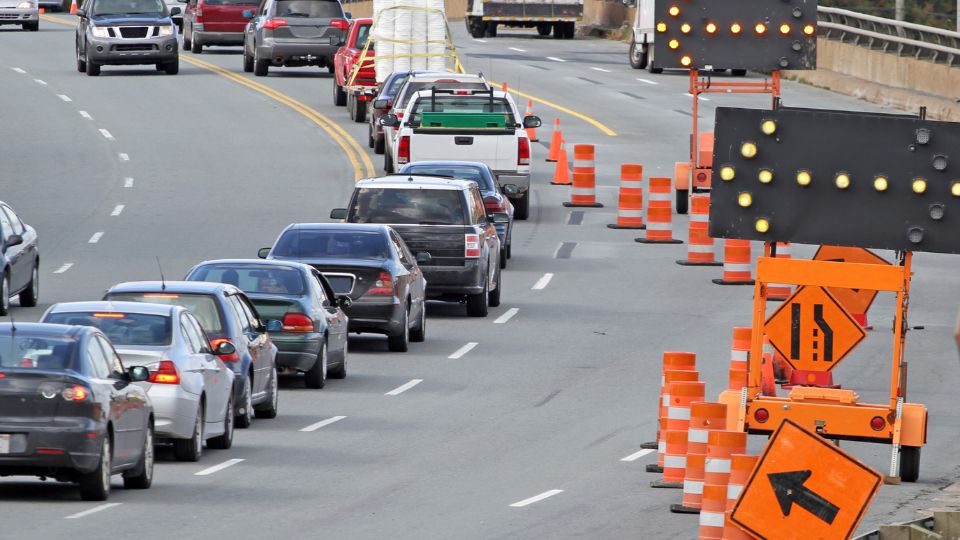A wide range of careers awaits those who earn the certification to work as a traffic controller. Doing work in this area can have significant payoffs. A traffic controller can contribute to the safety of:
- Commuters
- Staff, and
- Pedestrians
But, there are several requirements you must fulfil before you can start working as a legal traffic controller. Formal education and acquiring some fundamental skills are preconditions for this position.
The Benefits Of Working In Traffic Control
Traffic controllers are crucial service providers for a country. The function provides enormous inner joy and emotional fulfilment and securely leads traffic to its destination.
Possible benefits of working in traffic control include:
- Job security: As the demand for infrastructure and road work increases, so does the requirement for an accredited traffic controller. This can bring work security and stability.
- Work diversity: A traffic control job can encompass several projects, work conditions, and locations, giving variety and possibilities for growth and learning.
- Flexible work arrangements: A traffic control job can provide flexible work arrangements such as part-time, full-time, casual, and contract work.
- Competitive pay: Traffic control jobs can pay well, including penalty rates and overtime pay, especially for those outside typical business hours.
- Possibilities for advancement: An experienced traffic controller can advance to managerial or supervisory roles.
- Contribution to the community: Traffic controllers play a crucial role in keeping the public safe by monitoring traffic flow through work zones. This can bring a sense of accomplishment and fulfilment in giving to the community.
What Exactly Does A Traffic Controller Do To Control Traffic?
A traffic controller is responsible for managing the movement of automobiles and other equipment on roadways and construction zones. More than merely holding a stop/slow bat, this job requires many skills.
A traffic controller is responsible for a variety of duties, including but not limited to the following:
- Steering traffic and guiding foot traffic: A traffic controller’s primary duty is to ensure the well-being of pedestrians and construction workers (such as construction managers, site managers, civil engineers, and builders). They frequently use signs to direct traffic and instruct visitors on moving around the property without causing any accidents.
- The Installation of Warning Signs and Safety Barriers: Before work begins, the traffic officer and site supervisor implement traffic management plans. Controllers may also work with inspectors, crew leaders, foremen, managers, auditors, and regulatory officials, depending on the nature of the services or job.
- Implementing a Strategy for Road Management: Most traffic control plans will map out pedestrian and vehicular corridors free from danger. Accidents can be prevented by marking the paths with signs, tape, or other barriers. Traffic regulators begin managing the flow of vehicles and pedestrians after putting up signs and safety obstacles. They might employ radio communication, appropriate communication devices, hand signals, and a “stop/slow” bat.
- Upkeep of Equipment and Sign Cleaning: The traffic controller’s day ends with cleaning and maintaining the day’s signs and machinery. They tally the number of signs and barriers used throughout the day, pick up any trash, and return the equipment to its proper location.
A traffic controller’s duties are not limited to those listed here. It’s possible, for instance, that traffic monitoring is an occasional requirement during an otherwise routine workday.
Skills And Qualifications Needed For A Traffic Controller In Australia?
To work as a traffic controller in Australia, you will need to possess several different skills and qualifications to become a traffic controller:
- Qualification for Traffic Control: You must complete a traffic control course approved by the relevant authorities, like RIIWHS205E Control Traffic using Stop-Slow Bat in Australia.
- RIIWHS302E Install Traffic Management Plan: In the RIIWHS302E course, students learn how to implement a traffic management plan. With the knowledge gained from this competency, you can carry out a traffic management strategy by all applicable regulations and guidelines.
- RIIWHS205E Control traffic with a stop-slow bat: This course will equip you on the proper use of portable traffic control devices to safely and efficiently manage vehicular traffic.
- RIIWHS206 Control traffic with portable traffic control devices and temporary traffic signs: This skill will teach you how to organise and monitor actions related to traffic control by a traffic management plan.
- RIICOM201E Communicate in the workplace: This course emphasises effective communication in the workplace. Speaking clearly and concisely with other staff and road users is essential in the role of the traffic regulator.
- RIIWHS201E Work safely and follow WHS policies and work procedures: This course prepares you to work safely and by workplace procedures and WHS policies.
- White Card: To work as a traffic controller, you must secure a “white card,” a government-issued work visa. Construction site safety is a priority throughout Australia, and the white card course is widely recognised as the best way to achieve this goal.
- Licence to Drive: Possession of a current and valid driver’s licence is required as you may be required to operate a Vehicle or Travel to Several Work Locations.
- Pay attention to the Details: To keep everyone on the road safe, you must pay close attention.
- Medical Fitness: A job in traffic control requires a strong body and the physical ability to work in any condition.
- Problem-Solving Skills: Quick thinking and problem-solving abilities are essential.
Participants will learn both theoretical concepts and practical skills. The theoretical training of the course is done via lectures. The next step of the curriculum is for students to undergo practical training in a simulated workplace.
After completing the course, you must take an evaluation test to show that you have mastered the information given in the traffic controller training.
You will receive a statement of competence once you have finished the programme and assessment. This enables you to work as a traffic controller. There is a 90-day grace period for this declaration.
An individual must acquire certification to be issued a licence. The State Roads Authority accepts applications both online and in person. Accreditation is granted after approval and remains in effect for three years.
A renewal course must be taken to maintain accreditation. The initial training and the renewals must be completed through a registered training organisation.

What Steps Do You Have To Take To Become A Licensed Traffic Control Controller?
To become a certified traffic controller in Australia, you must normally complete the following steps:
- Comply with the eligibility requirements: To execute the tasks of a traffic controller in most states and territories, you must be at least 18 years old, have a valid driver’s licence, and pass a physical examination.
- Finish a nationally recognised training course: You must complete a training course that covers the required traffic control competencies. A registered training organisation (RTO) approved by the relevant state or territory regulatory agency should provide the course.
- Get a Statement of Attainment: Upon successful completion of the training course, you will be awarded a Statement of Attainment, a nationally recognised qualification demonstrating your proficiency in traffic control.
- Apply for accreditation or licencing: To operate as a traffic controller, you may need to apply for accreditation or licensure in your state or territory. This requires you to submit your Statement of Attainment, fill out an application form, and pay a fee. You may also be required to submit to a criminal background check and produce identification.
- Complete refresher training: To maintain your accreditation or licence as a traffic controller in several states and territories, you must complete regular refresher training.
Remembering that the prerequisites for becoming an authorised traffic controller in Australia can differ between states and territories is crucial. As a result, it is advised to contact the relevant regulatory agency in your state or territory for precise information on the requirements and process.
Necessary Traffic Controller Accreditation In Australia
The Australian Skills Quality Authority (ASQA) and individual state and territory governments are responsible for traffic controller accreditation in Australia.
In Australia, being a traffic controller often necessitates completing a training programme that has been approved nationally and provides instruction in all of the necessary skills. The course often has theoretical and practical components and is provided by Registered training organisations.
A Statement of Attainment, an officially recognised credential, will be issued to you once you finish the training programme. While some jurisdictions require a licence or accreditation to act as a traffic controller, this is different.
A traffic controller’s job in some states, such as New South Wales and Victoria, requires certification or licence from the appropriate agency. You’ll need to pass more tests and show proof that you’re OK to go, such as a clean criminal record check and a medical examination.
It is crucial to verify with the appropriate regulatory body in your state or territory for detailed information on the traffic controller certification or licensure, as these can differ between states and territories in Australia.
Which Australian Regulatory Authority Oversees Registered Traffic Management Companies?
In Australia, the entity in charge of regulating registered traffic management companies is normally the department of roads and transport of the state or territory government.
For example, in New South Wales, the Roads and Maritime Services (RMS) regulates and accredits traffic management firms. In contrast, VicRoads is in charge of regulating and accrediting traffic management companies.
Typically, these regulatory agencies require traffic management companies to meet particular requirements and criteria to provide safe and effective traffic management services. They may also undertake audits and inspections of traffic management businesses to ensure these criteria are continuously met.
In addition to state and territory regulatory bodies, Australia has industry associations such as the Traffic Management Association of Australia (TMAA) and the Australian Road Research Board (ARRB), which provide guidance and support to traffic management companies and help to ensure the industry’s best practices.
Traffic Controllers Workplace Induction Training Course
Before starting work, Australian traffic controllers must attend a mandatory induction training programme. The course material includes the following:
- Constraints imposed by law and policy on traffic management,
- Management strategies for traffic flow,
- Communication abilities
- Safety practices, and
- Competence in the day-to-day tasks involved in traffic management and control.
Typically, the course is made available online and in person through RTOs approved by the appropriate state or territory authority. After successfully completing the course, students will receive a certificate of accomplishment that can be used to apply for Traffic Controller certification in Australia.
How to become a traffic controller in Australia – one must complete an approved traffic controller training Course. These classes are normally provided by RTOs approved by the appropriate regulatory body in a certain state or territory.
How Can I Become A Traffic Controller In Queensland?
To become a Traffic Controller in Queensland (QLD), Australia, you must finish a course and get a Traffic Controller certificate from an RTO recognised by TMR.
Topics covered in the Traffic Controller (TC) course include:
- Legislation and principles for traffic control
- Personal safety, as well as the protection of others
- Traffic control devices
- Site evaluation and risk management
- Communication abilities
To be eligible for the Traffic Control training, you must meet the following requirements:
- Must be at least 18 years old
- Have a valid driver’s licence or access to a licenced driver for transportation
- you to and from work locations
- Have fundamental literacy and numeracy skills
You must apply for a Traffic Controller licence through the Department of Transport and Main Roads once you have completed the traffic controller course and acquired your Traffic Controller accreditation. A current First Aid Certificate and a White Card are also required (General Construction Induction Card).
It is also crucial to remember that becoming a Traffic Controller in Queensland necessitates a high level of physical fitness and the ability to operate outside in various weather situations.
Traffic Management Industry In Australia
The Australian traffic management industry coordinates the flow of vehicular, foot, and bicycle traffic on the country’s roads, streets, and highways. It’s a crucial sector that works to improve urban transportation safety and efficiency.
The Australian Road Research Board and Austroads are two organisations that help guide and standardise traffic control industry practices and fall under the purview of the state and territory governments that regulate the industry. Many non-government organisations (NGOs) also offer services related to traffic management, such as traffic control, traffic planning, traffic signal design and installation, and road safety audits.
The use of technology to enhance traffic management in Australia has become increasingly popular in recent years. Intelligent transportation systems (ITS) are used for this purpose; they collect information from sensors and cameras and use it to adjust traffic signals in real-time. There has also been a push towards greener, more active modes of transportation like cycling and walking, which must be considered when designing traffic flow.
Overall, Australia’s traffic management industry is critical to its ability to facilitate the free flow of people and goods across the country’s roads. It is constantly adapting to keep up with technological developments and shifting transportation preferences.

Traffic Management Signs
Road, street, and highway traffic can only be controlled or directed with traffic management signs. They inform motorists, pedestrians, and cyclists of critical data, including posted speed limits, road conditions, and potential dangers. To better manage traffic, many different types of signs have been developed.
- Regulatory signs: Rules of the road, such as speed limits, stop signs, and no parking signs, are all examples of regulatory signs.
- Warning signs: Signalling potential dangers on the road, such as sharp turns, steep hills, and school zones, are warning signs.
- Guide signs: The purpose of guide signs is to point the way to and inform drivers and tourists about specific locations and landmarks.
- Construction signs: Road construction signs alert motorists to road closures, lane restrictions, and reduced speed limits around a construction site.
- Temporary signs: Signs that are only up for a limited time are used for temporary road closures due to things like accidents or special events.
- Information signs: As the name implies, informational signs inform motorists about nearby amenities like restaurants, service stations, and rest stops.
- Bicycle and pedestrian signs: Signs for bicyclists and pedestrians: these indicate bike lanes, crosswalks, and shared-use trails, respectively.
What Is The Difference Between Traffic Signs and Safety Signs?
| Key Differences | Traffic Signs | Safety Signs |
| Purpose | Manage and direct traffic flow | Alert people to hazards and provide safety information |
| Location | On or near roads, streets, and highways | In various locations, such as buildings, construction sites, and industrial facilities |
| Content | Information about traffic rules and regulations, such as speed limits and lane closures. For example “Reduce Speed on Icy Roads” sign | Information about potential hazards and safety instructions, such as warning of electrical, heat hazards or instructions for emergency exits |
| Design | Specific shapes, colours, and symbols communicate their intended meaning to drivers and pedestrians. For example, a “Warning of concrete works in progress or roadwork” sign typically has an orange background with bold black text on a white background | Bright colours, symbols, and text alert people to hazards and provide safety information. For example, the warning sign for “Asbestos Hazard” and “Dogging, Rigging, Lifting operation” typically has a yellow or red background colour, which are standard colours used for warning signs |
How Much Do Traffic Controllers Earn In Australia?
In Australia, the national median salary for a Traffic Controller is $29 per hour. In Sydney, for example, the average hourly wage is $32.04, with some employers giving up to $50 per hour.
Your salary is also affected by your job, experience, and industry. An experienced traffic controller should expect to earn more than an entry-level post.
Full-time, part-time, and temporary roles may be available. With their working holiday visas, many foreign travellers gain the necessary accreditation to seek temporary employment.
You can find traffic controller jobs in Australia through a variety of channels, including staffing agencies, online job boards, and personal contacts.
Can An International Student Work As Traffic Controller?
International students in Australia are usually only allowed to work up to 40 hours every two weeks while classes are in session. But they can work as many hours as they want during semester breaks or vacations, depending on the conditions of their visas. This means international students with the qualifications and certifications can work as Traffic Controllers in Australia.
A Traffic Control Certificate and a Construction Industry White Card are required to work as a Traffic Controller in Australia. These credentials can be obtained by enrolling in a registered training organisation (RTO) course. International students who meet the eligibility requirements can enrol in these courses.
Suppose an international student fails the required qualification and certification tests. In that case, they must retake it or complete additional training to improve their knowledge and skills. It should be noted that additional costs may be associated with retaking the test or completing additional training, and these costs are the student’s responsibility.
Working as a Traffic Controller can be physically demanding and may necessitate working outside in varying weather conditions. Before enrolling in a training course or accepting a job offer, international students interested in this occupation should make sure they understand the job requirements and working conditions.
What Is A Traffic Light Controller?
In Australia, a traffic light controller is an electronic system that controls traffic lights at intersections and pedestrian crossings. The system is intended to ensure safe and efficient traffic flow while minimising congestion and delays.
The traffic light controller system comprises several components, such as:
- Sensors that detect the presence of vehicles or pedestrians
- Timers that control the duration of the green, yellow, and red lights
- Software that coordinates the operation of multiple traffic lights at an intersection
In Australia, local councils or state government authorities usually install and maintain traffic light controllers. These authorities collaborate closely with traffic engineers and other experts to design and implement traffic management plans that help keep roads safe and traffic congestion minimal.
Individuals in Australia who want to work as a traffic light controller technician typically need a relevant trade qualification, such as an electrical or electronic engineering degree or an apprenticeship in electrical or electronic systems. They may also be required to have a valid driver’s licence and to complete additional traffic management and safety training or certification.

What Is A Traffic Light Controller?
In Australia, a traffic light controller is an electronic system that controls traffic lights at intersections and pedestrian crossings. The system is intended to ensure safe and efficient traffic flow while minimising congestion and delays.
The traffic light controller system comprises several components, such as:
- Sensors that detect the presence of vehicles or pedestrians
- Timers that control the duration of the green, yellow, and red lights, and
- Software that coordinates the operation of multiple traffic lights at an intersection.
In Australia, local councils or state government authorities usually install and maintain traffic light controllers. These authorities collaborate closely with traffic engineers and other experts to design and implement traffic management plans that help keep roads safe and traffic congestion minimal.
Individuals in Australia who want to work as a traffic light controller technician typically need a relevant trade qualification, such as an electrical or electronic engineering degree or an apprenticeship in electrical or electronic systems. They may also be required to have a valid driver’s licence and to complete additional traffic management and safety training or certification.
What If I Am Already An Interstate Traffic Controller?
Suppose you are currently employed as an interstate Traffic Controller in Australia, in that case, you may continue to do so in other states and territories as long as you meet the requirements of that state or territory. Each state in Australia has its requirements for Traffic Controllers, and you must meet them to work in that state or territory.
You may need to obtain state-specific qualifications or certifications to work as a Traffic Controller in a new state or territory. It’s also good to check with local traffic management companies or government agencies to learn about any local requirements or regulations you should know.
It’s important to remember that Traffic Controllers’ duties and responsibilities, as well as their pay and benefits, can vary significantly between jurisdictions. Before beginning work, it is critical to research these differences and ensure that you are familiar with the requirements and conditions of the new state or territory.
Do All People Who Control Traffic Need Accreditation?
When it comes to keeping Australian roads safe and efficient, having the right credentials is essential for anyone in a traffic-controlling role. Individuals who are not required to be accredited as traffic controllers include:
- Officers of the law
- Drivers of escorting vehicles
- School crossing supervisors from the Department of Transportation and Main Roads
- State Emergency Service officers and
- Individuals who direct or divert traffic within a parking garage
How Long Will A Traffic Controller’s Accreditation Be Valid?
In Australia, the duration of a Traffic Controller’s accreditation is conditional on the type of accreditation held. The following timelines should be used as a general rule of thumb:
- A Traffic Control Certificate is valid for three years from the issue date. The certificate holder must take a renewal course every three years and pass the required exams to keep their certification current.
- A White Card in the construction industry does not expire and does not require renewal. However, your white card is no longer valid if you have not worked in the construction industry in the last two years.
The certifications of Air Traffic Controllers must be kept current and renewed before they expire. If the Traffic Controller fails to renew their credentials, they may no longer be able to perform their job legally.
Who Provides Training For Traffic Controllers?
In Australia, traffic controller training is provided by registered training organisations (RTOs) accredited by the Australian Skills Quality Authority (ASQA).
Traffic control legislation and regulations, workplace health and safety, traffic control plans, personal protective equipment, traffic control devices and equipment, communicating with road users, incident management, and traffic control at work sites are all covered in training.
Individuals who complete the training receive a three-year Traffic Control Certificate (also known as a traffic controllers ticket). Choosing an RTO registered and recognised by the regulatory authority in their state or territory is important.
How Does Construction Induction Training Boost Traffic Controller Confidence?
Construction induction training, also known as White Card training, can help traffic controllers build their confidence in the following ways:
- Facilitating an in-depth familiarity with construction industry safety norms and practices.
- Training traffic controllers in effective communication are crucial for fostering positive relationships with coworkers and the construction crew.
- Aiding in detecting dangers and evaluating risks at construction sites, traffic controllers can take the appropriate measures to avoid collisions.
- Making sure that traffic controllers know and understand their responsibilities under the law, such as following safety procedures and observing all applicable health and safety regulations on the job.
- Traffic controllers can better handle stressful situations by learning what to do in an emergency and how to stay calm under pressure.
- Traffic controllers gain the information, practice, and self-assurance from their construction induction training to do their jobs well and safely.
If you want to learn more about white card training, you can contact an accredited training provider.

